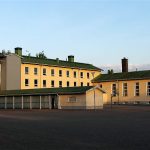Traveling, in my opinion, is so wonderful; The excitement of getting to see new places, meet new people, see loved ones you might not have gotten to spend time with lately, try new things, etc. However, there is one thing that all travels have in common: having to sit for long periods of time. No matter which mode of transportation you take, it all involves sitting. In my work as a yoga instructor and body worker, the most common complaint I hear from people, especially those that have desk jobs, is that they have lower back and hip pain/tension. The older I get and the more I sit, I feel it too! I’m coming to the conclusion that we should all stand, all the time, with really comfy shoes. No, I’m just kidding . . . sort of.
Here’s the secret to dealing with the hip and low back pain….
You have to strengthen and stretch the surrounding muscles too. Stretching just the hips an/or lower back will not be enough to keep the pain away. Specifically which ones? The upper legs, and the torso. Yep, everything in those regions. This isn’t as complicated as you might imagine. Most yoga poses take care of multiple regions at one time. Very efficient, isn’t it? This is one of the many reasons I love it so much, and will continue doing yoga until I’m a very old lady.
With these poses, I like to work them into a sun salutation series, but they can easily be done singularly, on their own. Be sure to practice them on each side!
These are all very well known, common yoga poses, so you may recognize some or even all of them!
Warrior 1 (Virabhadrasana 1)
Step one foot forward into a lunge, with the front foot facing forward with the knee over the ankle, and the back leg straight with the foot at a 90 degree angle. Both hips should be facing forward and raise the arms straight into the air. As you’re able, turn your gaze to the sky.
This pose engages the gluteal muscles, quadriceps, and hamstrings, while intensely stretching the hip flexors in the back leg, the torso and possibly the calves.
Warrior 2 (Virabhadrasana 2)
From the warrior 1 position, keep the feet in the exact same position but open the torso and hips to the side and bringing the arms parallel to the floor reaching one forward and one back. The front knee may need to rotate outward slightly to stay over the ankle. Turn your gaze over your front fingertips.
This pose engages the gluteal muscles, quadriceps, and hamstrings, while stretching the front leg adductors (inside the thigh) and the back leg hip flexor.
Reverse Warrior (Viparita Virabhadrasana)
From the warrior 2 position, keep the legs and feet exactly where they are. Lean backwards slightly, reaching the back hand to meet the back leg, either above or below the knee (not ON the knee!!), and the front arm straight up. As you’re able, turn your gaze up towards your raised hand. Tighten your butt muscles on the back leg side to help protect your back from injury.
This pose engages the gluteal muscles, while stretching the hip flexor in the back leg, and the obliques (side muscles) in the torso.
Extended Side Angle Lunge (Utthita Parsvakonasana)
From the reverse warrior position, keep your legs and feet as they are. Rotate the arm that was in the air, down to either your bent knee, or extended down to the floor. (I have very short arms so I use my knee to keep myself in the proper position) Engage your torso muscles to keep your weight out of your supporting arm. Now, extend the other arm over your head to reach a 45 degree angle. This should create a straight line from your foot to your fingertips.
This pose engages your hamstrings while stretching the adductors in the front leg and the obliges on the back facing side.
Triangle Pose (Trikonasana)
From the extended side angle pose, come back into the warrior 2 position. Straighten the front leg and lift your torso up and away from the hips. Slide your rib cage forward over the front leg and then rotate the arms and upper body so that the upper body is parallel to the floor and the arms are perpendicular. You can rest the bottom hand on your ankle, on a block, on the top of your foot, or with the fingertips barely touching the floor. Turn your gaze towards the sky.
This pose engages the core muscles while stretching the obliques, hamstrings, and adductors.
















